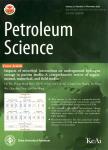Main progress and problems in research on Ordovician hydrocarbon accumulation in the Tarim Basin
Main progress and problems in research on Ordovician hydrocarbon accumulation in the Tarim Basin作者机构:Basin and Reservoir Research Center School of Natural Resources and Information Technology China University ofPetroleum Beijing 102249 China State Key Laboratory of Petroleum Resources and Prospecting China University of Petroleum Beijing 102249 China PetroChina Tarim Oilfield Company Korla Xinjiang 841000 China
出 版 物:《Petroleum Science》 (石油科学(英文版))
年 卷 期:2010年第7卷第2期
页 面:147-163页
核心收录:
学科分类:0820[工学-石油与天然气工程] 08[工学]
基 金:supported by the National Basic Research Program of China (973 Program Grant No.2006CB202308)
主 题:Tarim Basin carbonate reservoirs oil and gas exploration of the Ordovician hydrocarbon accumulation mechanism hydrocarbon enrichment rule
摘 要:The Tarim Basin is the largest petroliferous basin in the northwest of China, and is composed of a Paleozoic marine craton basin and a Meso-Cenozoic continental foreland basin. It is of great significance in exploration of Ordovician. In over 50 years of exploration, oil and gas totaling over 1.6 billion tonnes oil-equivalent has been discovered in the Ordovician carbonate formation. The accumulation mechanisms and distribution rules are quite complicated because of the burial depth more than 3,500 m, multi-source, and multi-stage accumulation, adjustment, reconstruction and re-enrichment in Ordovician. In this paper, we summarized four major advances in the hydrocarbon accumulation mechanisms of Ordovician carbonate reservoirs. First, oil came from Cambrian and Ordovician source rocks separately and as a mixture, while natural gas was mainly cracked gas generated from the Cambrian-Lower Ordovician crude oil. Second, most hydrocarbon migrated along unconformities and faults, with different directions in different regions. Third, hydrocarbon migration and accumulation had four periods: Caledonian, early Hercynian, late Hercynian and Himalayan, and the latter two were the most important for oil and gas exploration. Fourth, hydrocarbon accumulation and evolution can be generally divided into four stages: Caledonian (the period of hydrocarbon accumulation), early Hercynian (the period of destruction), late Hercynian (the period of hydrocarbon reconstruction and re-accumulation), and Himalayan (the period of hydrocarbon adjustment and re-accumulation). Source rocks (S), combinations of reservoir-seal (C), paleo-uplifts (M), structure balance belt (B) matched in the same time (T) control the hydrocarbon accumulation and distribution in the Ordovician formations. Reservoir adjustment and reconstruction can be classified into two modes of physical adjustment and variation of chemical compositions and five mechanisms. These mechanisms are occurrence displacement, biodegradat




